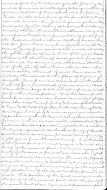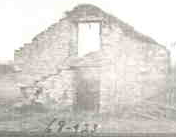San Juan Mill is one of the historic mills of San Antonio, Texas which is currently laying in ruins. This historic mill has not protected very well and is in disrepair. Sadly this historic mill has been long forgotten as vegetation has overgrown and overlapped the former mill structure. This news article will explain and explore some of the history behind San Juan Mill. San Juan Mill operated under names such as Kerr and Higginbotham Mill, Berg Mill Grothaus Mill.
The land where San Juan Mill is located predates the statehood of Texas as the land was originally part of the Juan Francisco Gomez land grant. Juan Francisco Gomez sold this land property to Jose Antonio de la Garza who in turn sold the land to Roderick T. Higginbotham on January 4, 1842. Higginbotham had a mill installed on this land. Kerr and Higginbotham Mill was built in 1842 and began operating in 1842. This mill would become what was once known as the “Kerr and Higginbotham Mill” and eventually the "San Juan Mill". (Ref: https://npgallery.nps.gov/GetAsset/e390f8f1-2a60-4611-90a6-03fea6eb015d)



Joseph Anderson bought the property with the mill still functioning in 1859. He would own this land for a long time. The name of the mill was changed from “Kerr and Higginbotham Mill” to "San Juan Mill". The name "San Juan Mill" stuck longer than “Kerr and Higginbotham Mill”. (Ref: Bexar County Land Deeds, Volume R1, Pages 333-334)
Kerr and Higginbotham Mill ceased operations in 1866. Joseph Anderson shut off any of the channels connecting to the mill. The grist mill was still there. (Ref: https://scholarworks.sfasu.edu/cgi/viewcontent.cgi?article=1404&context=ita)
Joseph Anderson sold this land to Louis Ashley as the "San Juan Mill Tract" in 1873, being the same property upon which the mill known formerly as Kerr and Higginbotham's saw and grist mill was originally situated but later fell into disuse. (Bexar County Land Deeds, Volume 1, Pages 142-143)
Louis Ashley operated a grist mill and mill house here when he leased this property to the Berg Brothers and C.N. McLean which began operating in 1879. Louis Ashley and E M Ashley leased the land property to H L Berg beginning in 1881. The land covering the mill site was to be later the site of the Berg Brothers wool mill in 1881. This mill would become what was known as Berg’s Mill (Bergs Mill) and soon a community called Berg’s Mill was established in 1881. (Ref: Bexar County Land Deeds Volume 19, Pages 213-214)



The San Juan Mill was built in 1884 by F. E. Grothaus. Another part of San Juan Mill was built in 1885. San Juan Mill was fully functioning by 1886. (Ref: https://scholarworks.sfasu.edu/cgi/viewcontent.cgi?article=1404&context=ita)
San Juan Mill was also know as Grothaus Mill. Grothaus had moved from the downtown area to live and operate a mill in the Bergs Mill area. He still maintained other business interests in town. North of this mill was a dam that fed water into a race and that led to the water turbine. The dam had served the Texas Powder Company in earlier years.

The land continued to be leased by members of the Ashley family as part of the "mill tract" encompassing the former Berg Brothers operations. E M Ashley and F Ashley leased the land property out to E Speicer in 1890. (Ref: Bexar County Land Deeds, Volume 70, Pages 65-68)
San Juan Mill was operated by the Mission of Oblate Fathers from 1908 to 1927. Mission of Oblate Fathers was affiliated with the Catholic Church. (Ref: https://texashistory.unt.edu/ark:/67531/metapth432394/m1/57/zoom/?q=%22san%20juan%20mill%22&resolution=3&lat=1324.3368441946614&lon=4239.771199590454)




Grothaus Mill processed corn, as well as sugar cane, from the experimental farm at Stinson Field. San Juan Mill operated until 1930. The Great Depression is what led to the decline of San Juan Mill. Establishment of other mills in the San Juan area and Berg’s Mill area are what also led to the decline. That is why the mill discontinued functioning in 1930. (Ref: https://npgallery.nps.gov/GetAsset/e390f8f1-2a60-4611-90a6-03fea6eb015d) 
Upper and lower sections of the Berg’s Mill stone building were still structurally intact in the 1950s. The stone ruin of what was once formally known as Berg’s Mill is overgrown with foliage and is in bad repair currently. Much of these walls have disappeared due to constant vandalism. Vegetation overgrows on the land of what was once a mill called San Juan Mill.
According to land records from Bexar County Central Appraisal District, the land surrounding the ruins of San Juan Mill was in what was called "Ashley Park." San Antonio River Authority bought this land from L.E. Drakes prior to channelization in 1954. (Ref: Bexar County Land Deeds, Volume 3541, Page 278)
1959 was the year San Antonio River Authority sold the land to Tom Roudebush and Carrie O. Roudebush whom had owned land on part of that same land in the surrounding area. San Antonio River Authority sold the land to Tom Roudebush and Carrie O. Roudebush on a claim deed in 1959. Tom Roudebush and Carrie O. Roudebush were the final owners preceding National Park Service and US Government. San Juan Mill was owned by Tom Roudebush and Carrie O. Roudebush for several years.
Tom Roudebush and Carrie O. Roudebush sold the land of which San Juan Mill was located on to National Park Service and US Government throughly executed through a warranty deed on the date of June 25, 1986. National Park Service and the US Government currently own San Juan Mill. Today San Juan Mill is overgrown with foliage and is in bad condition. (Ref: https://bexar.trueautomation.com/clientdb/Property.aspx?cid=110&prop_id=476266)





San Juan Mill is located at 8818 Mission Road, San Antonio, Texas, US 78214.
























No comments:
Post a Comment